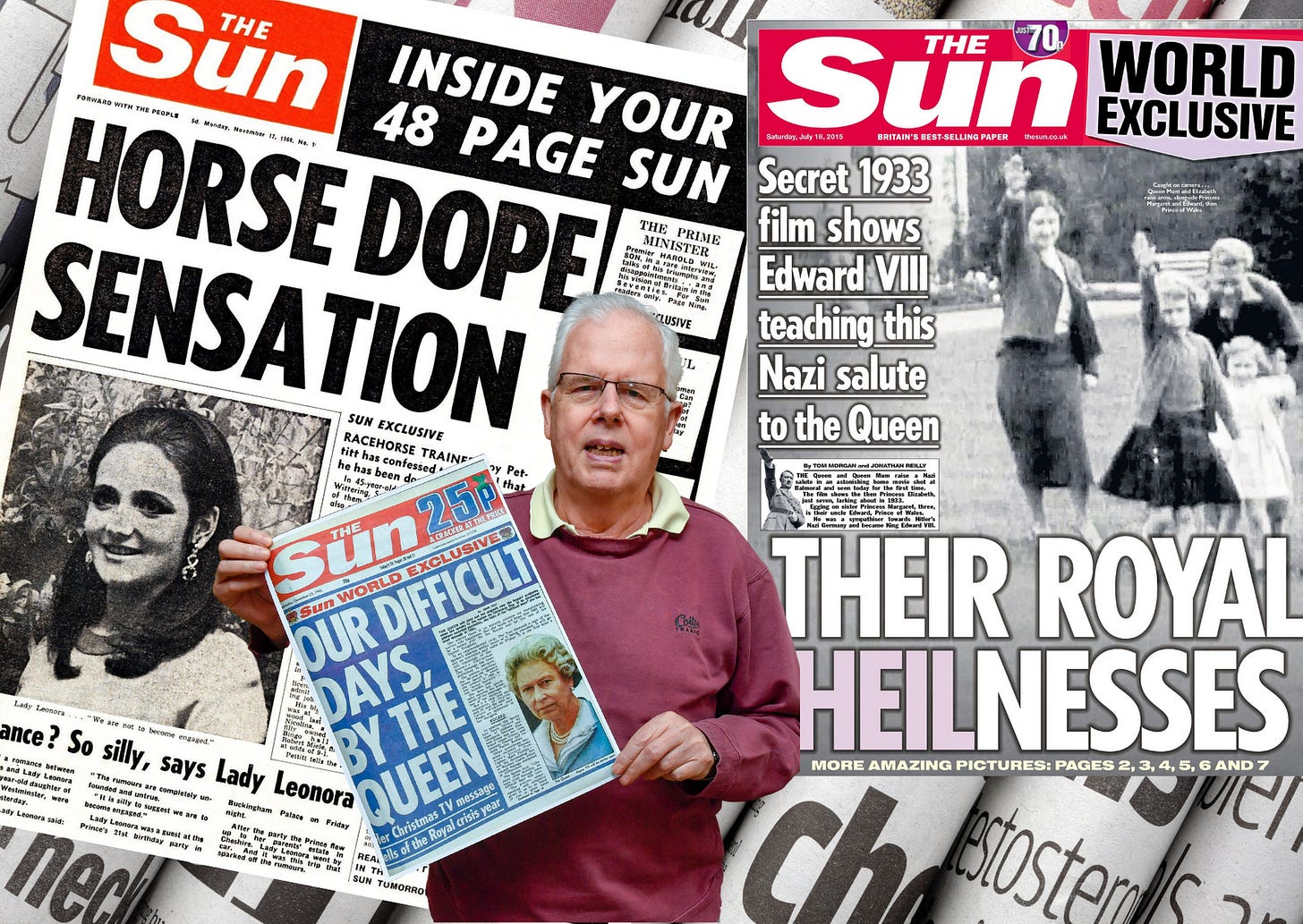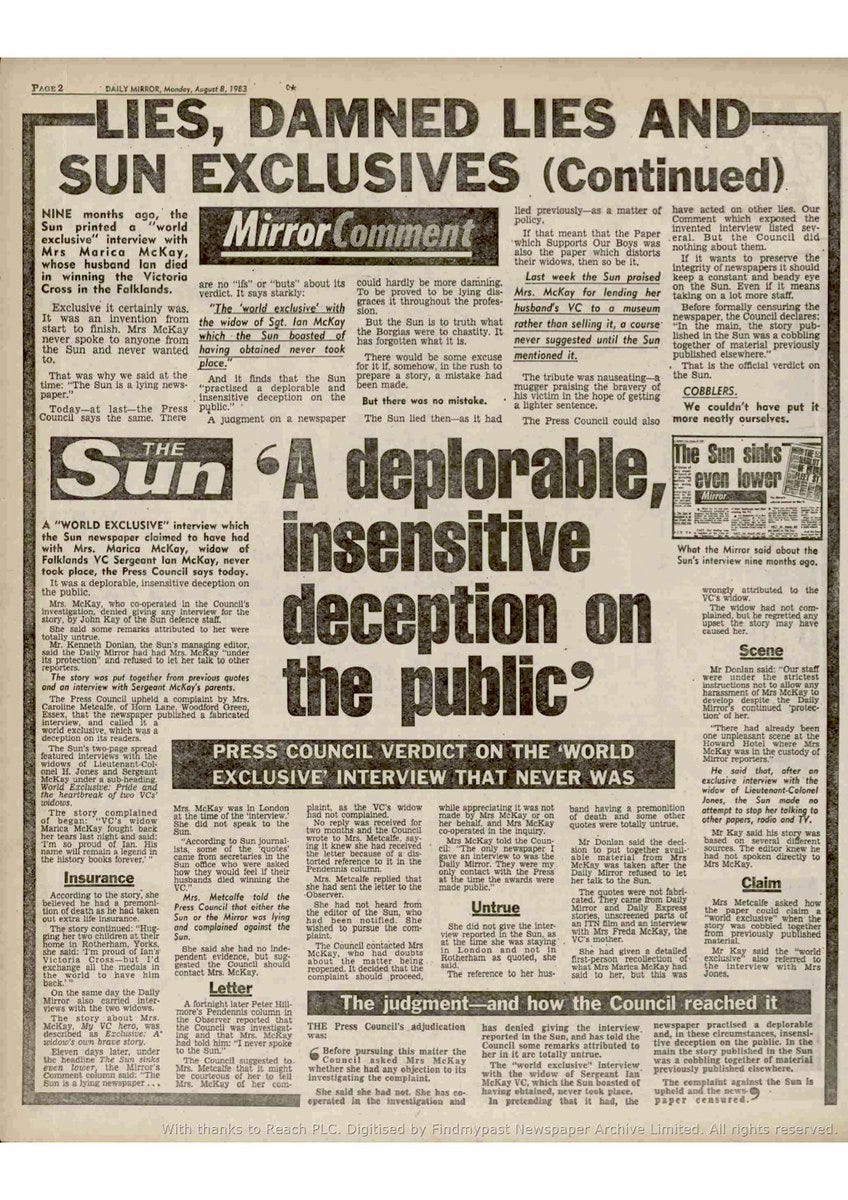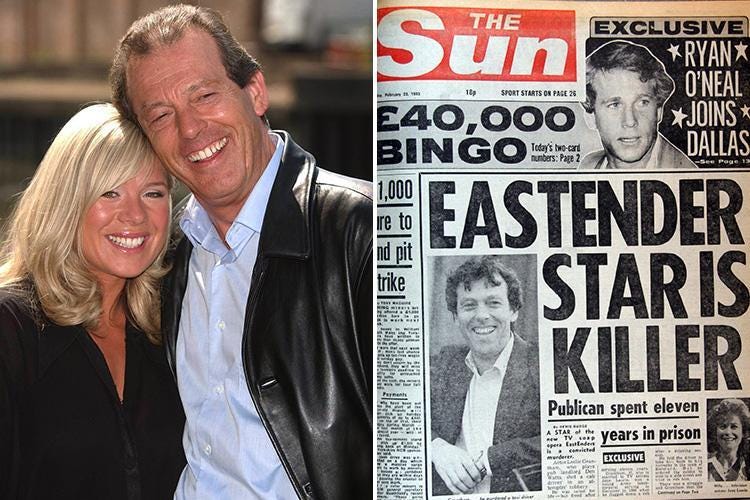Scoop! The killer excuses journalists make for our profession's crimes are vile...
... but getting the story is all that matters, right?
The response of a certain strain of hacks to the death of John Kay — The Sun’s former chief reporter whose 1977 killing of his wife, Harue, it neglected to mention at first in its glowing obit package — has been instructive. It neatly illustrates how getting “the scoop” can trump almost anything else in the unhinged world of the tabloid newsroom.
Press Gazette’s obituary for Kay came after the uproar about The Sun’s tribute and its editor, Dominic Ponsford, clearly thought he’d ducked that particular bullet. He wrote in yesterday’s Press Gazette newsletter that:
Today many former colleagues have paid tribute to the life of one of the greatest reporters UK journalism has produced - John Kay of The Sun - who has died aged 77.
Our obit looks at some of the highlights of that career, the sad end to it (under Operation Elveden) and does not ignore the awful events of 1977.
But the original text of the obit covered the killing in a rather glib and derisory manner. Early in the piece, there is a clunking line that reads:
His career was all the more remarkable given the personal catastrophe he was at the centre of in 1977.
Kay was found guilty of manslaughter by reason of diminished responsibility; that does not mean no responsibility.
Later in the original version of the obituary, Ponsford wrote:
One aspect of Kay’s life was never mentioned at The Sun but cannot be excluded from an account of it. In 1977 he had a mental breakdown and killed his wife before trying to take his own life. He pleaded guilty to manslaughter on grounds of diminished responsibility and was sentenced to treatment at a psychiatric hospital before being taken back afterwards by The Sun.
The copy failed to include Harue’s name and brushed aside the event in a single paragraph nestled in among many more stuffed with glowing praise. Would Kay, who led The Sun’s demand to reveal the new names of the Bulger killers, have offered such gentle treatment to a killer in the tabloid’s sights?
And before those four words — “by reason of diminished responsibility” — are raised in mitigation again, let’s consider how The Sun approach, for example, the mental health crisis suffered by Frank Bruno.
Kay was The Sun’s chief reporter when it published a front-page splash on Bruno which blared Bonkers Bruno Locked Up. The body copy referred to the former box as “a nut” and went into lengthy detail about his marriage break up and experience with depression and other mental health issues which had led to him entering a psychiatric hospital for treatment. Bruno didn’t kill anyone.
John Kay’s trial and subsequent time in Friern Barnet psychiatric hospital never appeared in Sun newsprint and was ignored by the rest of Fleet Street aside from a passing nib in the pre-Murdoch Times and a court report from The Guardian. His past was swept away on the say-so of News International.
After it was rightly and widely castigated for its coverage of Bruno, The Sun cynically established a charity fun for people suffering from mental illness. In the second edition of the paper, it stuck a new headline on the piece, which was hardly any better — Sad Bruno in Mental Health Home — and switched from calling him “a nut” to lauding him as “a hero”.

As I wrote yesterday, the issue is not that The Sun took Kay back. Retribution and rehabilitation are important. The problem is that its experience with Kay and his experience at Friern Barnet seemed to have no effect on the way either The Sun or its chief reporter treated other ex-offenders or considered the prospects of other killers trying to move on.
Faced with continuing criticism on Twitter for the way that Press Gazette’s obit breezed past Harue’s killing, Ponsford tweeted:
It’s been really quite something to read the vindictiveness and callousness among some on Twitter directed at journalists over [the] death of John Kay. I’ve updated the obit with some more detail about 1977 taken from [The] Guardian at the time.
For anyone who studies the daily callousness of The Sun, something John Kay contributed to for decades, the pearl-clutching will feel ridiculous. Many hacks come from the ‘facts don’t care about your feelings’ school of thinking until the person being criticised is them or one of their friends. At that point, they swiftly enrol at Madame Delicate’s Academy for the Emotionally Frail.
The updated obituary still contains the line about his career being “all the more remarkable…” but now expanded to read:
Some said his subsequent career was all the more remarkable given the breakdown he suffered in 1977 and his conviction for manslaughter by reason of diminished responsibility.
Harue Kay — no reporting notes her maiden name — was a young woman when Kay killed her. She had no chance to have a remarkable career. We have no idea what she could have done, what kind of luxurious obit she might have earned with an extra 44 years of life. We don’t even know for sure how old she was — some reports say 27, others 33.
There is no picture of her.
John Kay’s photograph is in the National Portrait Gallery.


The expanded section of the Press Gazette obit on the events of 1977 comes after a tribute from former Sun managing Graham Dudman — who like Kay faced accusations of illegal payments to public officials though unlike him did not go to trial as the charges were dropped by the CPS — which concludes:
John Kay was a class act. In many ways, he was The Sun newsroom. He has left us far too soon.
It’s a sharp gear change then when Ponsford writes:
One aspect of Kay’s life was never mentioned at The Sun but cannot be excluded from an account of it. In 1977 he had a mental breakdown and killed his wife Harue before trying to take his own life.
He pleaded guilty to manslaughter on grounds of diminished responsibility and was sent by a judge for treatment at a psychiatric hospital before being taken back afterwards by The Sun.
According to a report in The Guardian of the case, Kay was “cracking up” over the prospect of promotion to be The Sun’s industrial editor.
He reportedly told police: “My mind seemed to be taken over by voices. I seemed possessed.” A psychiatrist told the court it was a story of a soul in torment.
He had been married for a year to 27-year-old Harue and the couple were said to be “idyllically happy”.
He was travelling back from the TUC conference in Blackpool when he was said to be in a black depression and hearing voices. He is said to have told colleagues: “They all know that I have cracked. I have lost it, my career is in ruins. I am not able to cope any more.”
Kay was taking a bath with his wife when he drowned her and then repeatedly tried to kill himself and was found by police after crashing his car at 80mph, the report in The Guardian states.
The additional detail, though written to excuse Kay as much as possible, is welcome. But the problem is that Press Gazette — the industry’s most respected trade title — thought it could brush aside the events in six or so lines within a praise-laden tribute. John Kay gets monuments built to him in verbiage, while Harue is a footnote, a deliberately forgotten and unspoken name.
But John Kay was a scoop machine, right? That’s far more important than the stolen potential of a young woman we never got the chance to know — in the tabloid mindset, at least. So let’s look at the stories that Press Gazette’s obit highlights as some of Kay’s greatest:
The first picture of Moors murderer Myra Hindley outside prison
The revelation that black twins were being born to a white couple after an IVF mix up
News that MI5 chief Stella Rimington was writing a book
Chelski: The news that Roman Abramovich was buying Chelsea Football Club
News in 1987 that Prince Edward had quit the Royal Marines during training
The 2000 revelation that an MI5 spy had a lost laptop containing secret information while waiting at a station.
The story he was most proud of was the publication in 1992 of the entire Queen’s Christmas speech in advance (it was the year of her famous annus horribilis when there was a fire at Windsor Castle and Charles and Diana split up)… Someone had played him a tape of the broadcast down the phone.
The way that the last ‘scoop’ came to Kay is illustrative of how many tabloid scoops are acquired: Either dropped into a reporter’s lap or purchased with piles of the newspaper’s cash. Actual investigations are few and far between because tabloids exist to give the impression of ‘talking truth to power’ while ensuring that the status quo is thoroughly propped up.
There’s no space in praise of Kay for one of his most notorious actions as a foot soldier for Rupert Murdoch. In 1982, The Daily Mirror — then owned by the pension-stealing, name-shifting, boat-tripping Robert Maxwell — published a leader column that screamed Lies, Damned Lies, and Sun exclusives. The trigger for it was the ‘work’ of John Kay.
The Sun had claimed to have a “world exclusive” interview with Maria McKay, the widow of Sergeant Ian McKay, who had been killed during the Falklands War. Under the headline Pride and heartbreak of two VCs’ widows, the paper claimed to have interview Mrs McKay and the widow of Lieutenant-Colonel ‘H’ Jones. But Mrs McKay had never spoken to The Sun.
Faced with a ferocious press pack, McKay had agreed to be interviewed by the Daily Mirror and Independent Television News. The Daily Mirror put her up in a hotel and Kelvin MacKenzie, then editor of The Sun, threw everything he could at getting to her. In Stick It Up Your Punter! The Uncut Story of the Sun Newspaper, Chris Horrie and Peter Chippindale recount:
[MacKenzie] marshalled his heaviest team to get to Mrs McKay… leading to what was euphemistically described at the later Press Council hearing as “an unpleasant scene” as the two sets of hacks clashed on the premises.
Unable to actually get the interview, The Sun cheated. Horrie and Chippindale continue the story:
The paper hit gold when a hack interviewed Mrs McKay’s mother-in-law… and obtained a full report of what her daughter-in-law had told her about the VC award. The resulting screeds of copy were filed [and] other hacks on the mob-handed job got their hands on unscreened parts of an ITN interview and further quotes to throw into the mix were gleaned from older stories in the Mail and the Express…
The tricky job of assembling this disparate material into one piece to provide a classic spoiler was handed to reporter John Kay. Since his rehabilitation from Friern Barnet mental hospital Kay had been kept in the office where he matured into the paper’s best writer, commanding awed respect from the subs for his speed, accuracy and ability to compose stories in such perfect Sun-ese they could just be dropped into the paper without alteration.
Kay’s command of ‘Sun-ese’ was still being lauded in 2011 when an edition of Radio 4’s Word of Mouth came from The Sun’s newsroom. He told Michael Rosen:
A reporter goes out and basically gets stories, finds information; we are the foot soldiers of the paper and what we produce are the nuggets of fact that our wonderful sub-editors then mould into this fantastic, peerless prose that appears every morning, six days a week.
When Rosen asked him what made a good tabloid story, he replied:
I like to say a classic Sun story would be Queen In Sex Triangle — now you couldn’t think of a bigger one fact story than that. Obviously, that’s never going to happen but that would be a massive story expressed in four words.
That’s The Sun’s mentality boiled down to a couple of lines — salaciousness, sensationalism, and sex (though written about with grim coyness) — and the revelation and relitigation of private pain is fair game… unless the person in question is one of its pals. Or, in Kay’s case, a valued footsoldier.
For the perfect example of why Ponsford’s pearl-clutching about the criticism of his Kay obituary but especially The Sun’s is so grim we have to jump back to 1985 when the tabloid was obsessed with the newly-launched Eastenders.
The paper discovered that Leslie Grantham, the actor who played the nasty pub landlord Den Watts, had murdered a taxi driver who tried to rob him while he was serving with the British Army of the Rhine in 1966. He was sentenced to 10 years and upon his release from Leyhill Prison in Glouchester, where he had done the final part of his time, he started working as an actor.
The Sun headline read Eastenders Star Is A Killer.
The Sun got the information on Grantham from a mole on the Eastenders set who had been selling gossip to it for some time. But to protect its source and keep the ‘scoops’ coming, it claimed that it had been contacted by a former Leyhill inmate who had recognised Grantham from the TV. It was bollocks as the story had been on Kelvin MacKenzie’s desk for weeks ahead of the series launch, but he had decided to keep the scoop until the first episode was out to ensure maximum impact.
John Kay was allowed his retribution — which included several Reporter of the Year awards — and the willing silence of his colleagues about what he had done. But Leslie Grantham, 19 years after he committed his crime, was splashed on the front page of The Sun — once and forever a killer.
For journalists, kill can be a very irregular verb — “you kill, they kill, we are at the centre of personal catastrophes…”
Dominic Ponsford sent me this response, which I am publishing here in full:
On your point about the changes to the John Kay obit, you might bear in mind that my day starts at 8am and I needed to file by 10am to get it in our newsletter. The details of what happened in 1977 are pretty scarce to say the least and I didn't want to go on what I could find third-hand from sources like Wikipedia. Later on in the morning I managed to track down The Guardian cutting from 1977 about Kay's manslaughter conviction (not available online but you can pay for it via a newspaper archive service). Once I had found that I was able to add in the extra details (including his first wife's name). With online publishing the first version of a story which goes up is very rarely the final one. We go with what we have and then add more information in as we find it on a breaking story like this.
I think coverage of Leslie Grantham rather proves the point that the tabloids are capable of allowing someone redemption. He was convicted of murder, whereas Kay was treated by the courts as someone who was sick rather than bad and was committed to a hospital rather than given a prison sentence
If you read reports in the tabloids, and everywhere else, of Grantham's death you will find most gave even less coverage to his much more serious crime than I did of John Kay's past.
I guess people took the view that the man he became was very different from the 19-year-old who murdered German taxi driver Felix Reese and that, having served his time, he was allowed a chance at retribution (whilst not ignoring his past crimes).
Kay had many close friends in journalism and my personal view is that the response those friends got from people who hate The Sun on Twitter was exceptionally cruel and thoughtless. I'm not talking about legitimate criticism of omissions in The Sun obit, I'm talking about human beings sharing their memories of a friend who had died days earlier. Yes, you may think The Sun is cruel and thoughtless but isn't that rather morally bankrupt as an excuse?
I will be linking to this page in tomorrow’s newsletter so people who only read the email will get Dominic’s perspective too.






